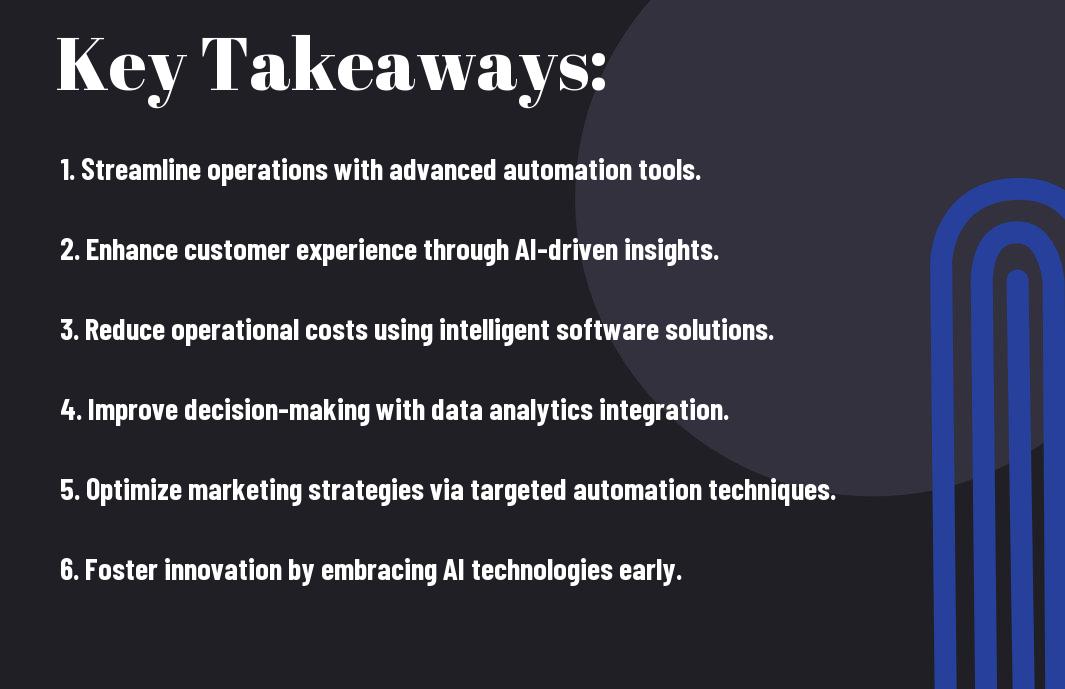
Automation is transforming the way you operate your business, enabling you to increase efficiency and productivity. By integrating AI and automation tools, you can streamline processes, reduce human error, and free up valuable time to focus on strategic growth. In this post, you will discover how to effectively leverage these technologies to not only enhance your operational capabilities but also scale your business to new heights. Let’s explore the various ways AI and automation can be your partners in achieving success.

Understanding AI and Automation
Your journey into leveraging AI and automation begins with a solid understanding of what these technologies truly are. AI refers to the simulation of human intelligence in machines programmed to think and learn, while automation involves using technology to perform tasks without human intervention. Both can significantly streamline operations, enhance efficiency, and contribute to overall business growth. In today’s digital landscape, harnessing these technologies has become imperative for staying competitive.
Definitions and Key Concepts
Around the world of technology, the terms AI and automation are often used interchangeably, yet they represent distinct concepts. AI encompasses systems that can process data, recognize patterns, and make decisions, whereas automation refers to any technology that reduces the need for human input in processes. Understanding these nuances lays the foundation for implementing these tools effectively in your business strategies.
The Role of AI in Modern Business
Above all, AI is transforming how businesses operate by providing insights and efficiencies that were previously unattainable. Companies are using AI to analyze data, predict customer behavior, and automate routine tasks, which enables you to focus on more strategic initiatives. This shift not only improves productivity but also enhances customer experience by personalizing interactions based on data-driven insights.
Understanding how AI fits into modern business practices is vital for any entrepreneur or business leader. By integrating AI into your operations, you can harness vast amounts of data to derive actionable insights, identify trends, and optimize processes. The ability to automate mundane tasks frees up your workforce, allowing them to devote their energies to innovation and customer engagement. In this rapidly evolving marketplace, leveraging AI is not just an advantage but a fundamental requirement for sustainable growth and success.
Benefits of Leveraging AI and Automation
If you’re looking to enhance your business operations, leveraging AI and automation can provide significant advantages. These technologies not only streamline processes but also enable you to make data-driven decisions, freeing up your time to focus on strategic initiatives. As a result, you can improve customer experiences and drive growth more effectively.
Increased Efficiency and Productivity
Benefits of AI and automation include heightened efficiency and productivity across your operations. By automating routine tasks, you can eliminate human error and reduce time spent on admin work, allowing your team to concentrate on core business functions. This shift results in improved performance and faster project turnaround times, driving overall success.
Cost Reduction and Resource Allocation
Increased efficiency often leads to cost reduction and more effective resource allocation. By implementing AI-driven solutions, you can minimize overhead expenses and optimize the use of your assets. This means you can do more with less, ensuring that your financial resources are spent wisely and strategically.
In addition to directly lowering costs, embracing AI and automation helps you reallocate resources where they are most needed. By identifying areas where automation can take center stage, you can focus your talents and budget on strategic initiatives and innovation, fostering an environment ripe for growth and sustainability.
Implementing AI and Automation Strategies
All businesses can benefit from integrating AI and automation strategies to enhance efficiency, reduce costs, and improve customer satisfaction. As you begin on this journey, it’s important to systematically analyze your operations to pinpoint where these technologies can have the greatest impact. This not only streamlines workflow but also enables you to scale your business effectively.
Identifying Areas for Automation
To identify areas for automation, start by analyzing repetitive tasks that consume valuable time and resources. Evaluate different processes within your organization to find inefficiencies or bottlenecks that hinder productivity. By focusing on these tasks, you can implement automation solutions that will free up your team to concentrate on higher-value activities.
Choosing the Right Tools and Technologies
To choose the right tools and technologies, consider factors such as your business size, the specific needs of your operation, and the ease of integration with existing systems. It’s important to conduct thorough research, comparing solutions and assessing user feedback, to determine which tools align with your objectives. Investing in the right technology ensures that you maximize your return on investment and achieve lasting efficiency gains.
Strategies for selecting the best tools involve aligning technology choices with your business goals and the specific tasks you wish to automate. Take the time to evaluate platforms that offer scalability, user-friendly interfaces, and reliable customer support. Engaging in conversations with vendors and seeking demo presentations can also help you better understand how each tool can enhance your operations. Ultimately, the right choices will empower your business to not only automate processes but also innovate and grow in an increasingly competitive landscape.
Overcoming Challenges in Adoption
Not all businesses adapt smoothly to AI and automation. Resistance to change, lack of technical expertise, and financial constraints can hinder your efforts. To successfully implement these technologies, you must address these barriers head-on, fostering a culture of innovation within your organization, and ensuring alignment on goals across teams. Embracing a flexible mindset and investing in training can ease the transition and help realize the potential of AI and automation for your business.
Addressing Workforce Concerns
By openly communicating with your team about the benefits of AI and automation, you can alleviate fears regarding job displacement. Educate your workforce on how these technologies can enhance their roles rather than replace them, encouraging collaboration between human talent and AI systems. This engagement will foster a sense of ownership and empowerment among employees, paving the way for successful adoption.
Data Privacy and Security Considerations
Adoption of AI and automation technologies necessitates a thorough understanding of data privacy and security challenges. As you integrate these systems, it’s imperative to ensure compliance with regulations and implement robust security measures to protect sensitive information. This proactive approach not only safeguards your business but also builds trust with your customers.
Understanding the implications of data privacy and security is vital as you leverage AI and automation. You need to establish clear policies on data handling, ensuring that your automated solutions adhere to industry regulations. Regular audits, employee training, and up-to-date security practices can help identify vulnerabilities and mitigate risks. This attention to detail not only protects your business but also enhances your reputation, making your customers feel secure when sharing their information.
Case Studies of Successful Implementation
After exploring various real-world applications of AI and automation, the following case studies illustrate their impact on business scalability:
- Company A increased its customer service efficiency by 40% through AI-driven chatbots.
- Company B achieved a 50% reduction in operational costs by automating inventory management.
- Company C boosted sales by 30% using personalized marketing algorithms powered by AI.
- Company D improved project turnaround time by 25% through the implementation of robotic process automation (RPA).
Small Businesses Scaling with AI
Across various industries, small businesses are harnessing the power of AI to enhance productivity and improve customer experiences. For example, a local retailer used AI for inventory forecasting, reducing stock-outs by 35% and improving sales predictability. By integrating AI tools, small businesses are not just surviving; they are finding new avenues to thrive and compete effectively.
Large Enterprises and Automation Strategies
With large enterprises scaling operations, adopting automation strategies is necessary for maintaining a competitive edge. Businesses have reported significant advancements in efficiency through streamlined processes and reduced manual intervention.
Consequently, utilizing automation solutions has allowed large enterprises to reallocate resources to strategic endeavors, increasing overall productivity. These companies have seen an average of 20% faster project completion and up to 60% improved accuracy in data processing. By embracing automation, you can transform your operational framework, leading to sustainable growth and enhanced profitability.
Future Trends in AI and Automation
Keep an eye on the rapidly evolving landscape of AI and automation, as these technologies promise to redefine business operations, enhance efficiency, and improve customer experiences. As you explore these advancements, consider how they can be integrated into your strategy to maintain a competitive edge in an increasingly digital world.
Emerging Technologies to Watch
With innovations such as quantum computing, advanced natural language processing, and autonomous systems on the horizon, your business can benefit from improved decision-making and streamlined processes. These emerging technologies will not only enhance operational efficiency but also allow you to provide personalized experiences to your customers.
Predictions for Business Landscape
Around the next decade, you can anticipate a shift where AI and automation become integral to virtually every business sector. This integration will enable you to leverage data-driven insights to make informed decisions, optimize workflows, and enhance customer engagement.
Even as AI and automation continue to mature, their potential impact on your business will likely expand. You may find that routine tasks become increasingly automated, allowing you to focus on strategic initiatives and innovation. Additionally, expect a rise in hybrid work environments where AI tools complement human expertise, driving collaboration and productivity to new heights. By staying ahead of these trends, you can position your business for sustained growth and success in an unpredictable future.
Conclusion
From above, it is clear that leveraging AI and automation can significantly transform how you scale your business. By integrating these technologies, you can streamline operations, enhance customer experiences, and make data-driven decisions that propel growth. Embracing AI and automation not only boosts efficiency but also frees you to focus on strategic initiatives that drive your vision forward. As you navigate this landscape, staying informed and adaptable will position you to harness the full potential of these advancements for your business success.
Leave a Reply